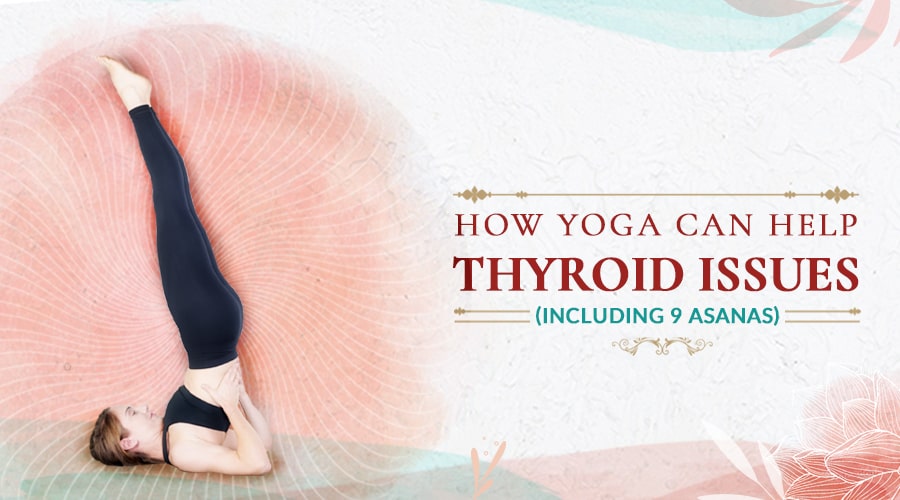Thyroid issues can cause unintentional weight changes, extreme mood swings and tiredness. It affects your everyday life and makes it challenging to be your old blissful self. Is there any way to manage these symptoms better? Yes, there is! Practicing yoga for thyroid issues can relieve related symptoms and improve the health of your thyroid. But before I get into how this works, what exactly does your thyroid gland do?
The thyroid is a small butterfly-shaped gland located in your throat. Its primary function is to produce hormones that affect your metabolism, body temperature, and growth. The thyroid-stimulating hormone (TSH), produced by the pituitary gland (located at the base of your brain), stimulates the thyroid to secrete these hormones.
The Most Common Thyroid Issues
The most common thyroid disorders are hyperthyroidism and hypothyroidism. Both affect the secretion of thyroid hormones. Managing these problems can be exceptionally challenging as these disorders affect your physical and mental health.
Hyperthyroidism
Hyperthyroidism, also known as an overactive thyroid, occurs when the thyroid produces too much of the thyroid hormones. The leading causes of hyperthyroidism are Graves' disease (an autoimmune disorder), thyroid inflammation and certain medications.
Symptoms of an overactive thyroid
- Fatigue
- Mood swings
- Anxiety
- Shaking hands
- Rapid heartbeat
- Heart palpitations (pounding heart)
- Dry skin
- Unintentional weight loss
- Increased bowel movements
- Menstrual cycle changes (light or missed periods)
- Sleep disturbances
Hypothyroidism
Hypothyroidism, also known as an underactive thyroid, occurs when the thyroid does not produce enough thyroid hormones. It is mainly caused by an autoimmune disorder called Hashimoto's disease, where antibodies attack and damage the thyroid cells. Hypothyroidism is more common than hyperthyroidism and primarily affects women.
Symptoms of an underactive thyroid
- Fatigue
- Weakness
- Depression
- Irritability
- Weight gain
- Dry skin and hair
- Hair loss
- Cold intolerance
- Muscle cramps
- Constipation
- Menstrual cycle changes (heavy or infrequent periods)
- Decreased sex drive
Whether you are diagnosed with a thyroid disorder or only experience some of these symptoms, there are certain yoga poses for thyroid issues which can relieve some of these symptoms. However, you must consult your doctor if you experience these symptoms regularly.
Why Practice Yoga For Thyroid Issues
Research has shown that regular yoga practices improve thyroid function. Although more research is needed to explain how this works, there are two theories: yoga improves thyroid function by (1) activating the parasympathetic nervous system and (2) increasing blood circulation to the thyroid glands.
Activates your parasympathetic nervous system
The autonomic nervous system can be divided into the sympathetic and parasympathetic systems. The sympathetic nerves are activated in stressful situations, while the parasympathetic nerves relax your body. Thyroid issues are often linked to stress due to the cortisol hormone interfering with the production of thyroid hormones. So because yoga relaxes the body (activating the parasympathetic nerves) and reduces stress, it improves thyroid function.
Increases blood circulation
Another reason why you should practice yoga for thyroid issues is that it increases circulation in the body. When you hold a pose, certain body parts are compressed, resulting in limited blood circulation to that region. As you come out of the pose or release pressure, oxygen-rich blood is rushed to the area that was previously blood (and nutrient) deprived. This is also called the squeeze-and-release effect and works best with glands such as the thyroid.
Disclaimer: If you suspect you may have thyroid problems, consult your doctor. Also, remember that yoga can help relieve symptoms but cannot replace treatments prescribed by your doctor.
9 Yoga Asanas to Improve Thyroid Health
The following yoga poses facilitate thyroid function by increasing blood flow to the thyroid gland and activating the Throat Chakra.
1. Shoulderstand (Sarvangasana)
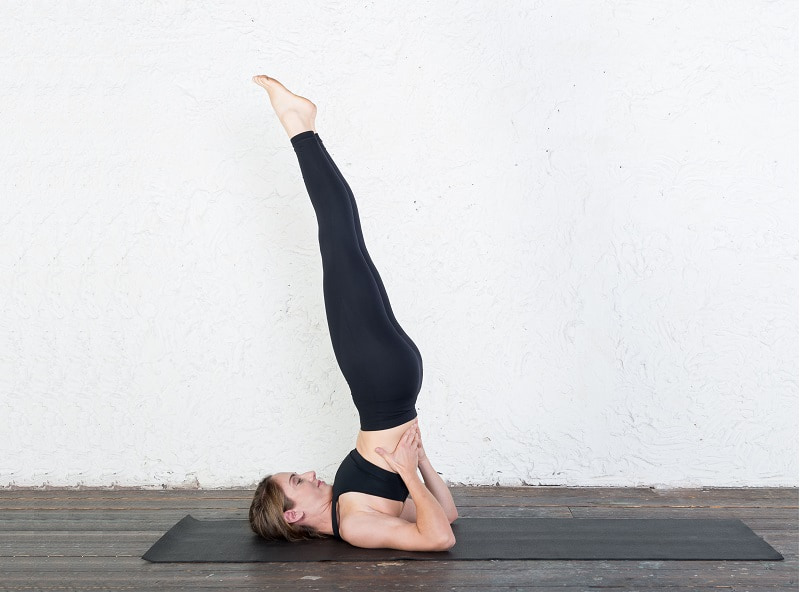
When practicing Shoulderstand (Sarvangasana), focus on stacking your ankles, hips and shoulders on top of each other. Although it is not always possible, keeping this alignment in mind will facilitate you to ‘grow’ in the pose. Another way to look at it is to keep 75 percent of your body’s weight on your shoulders and 25 percent on your elbows. To make this easier, draw your shoulder blades towards each other.
Modification
- To reduce pressure on your neck, place a folded blanket under your shoulder girdle.
Disclaimer: Do not practice Shoulderstand (Sarvangasana) if you are suffering from high blood pressure or other cardiavascular issues.
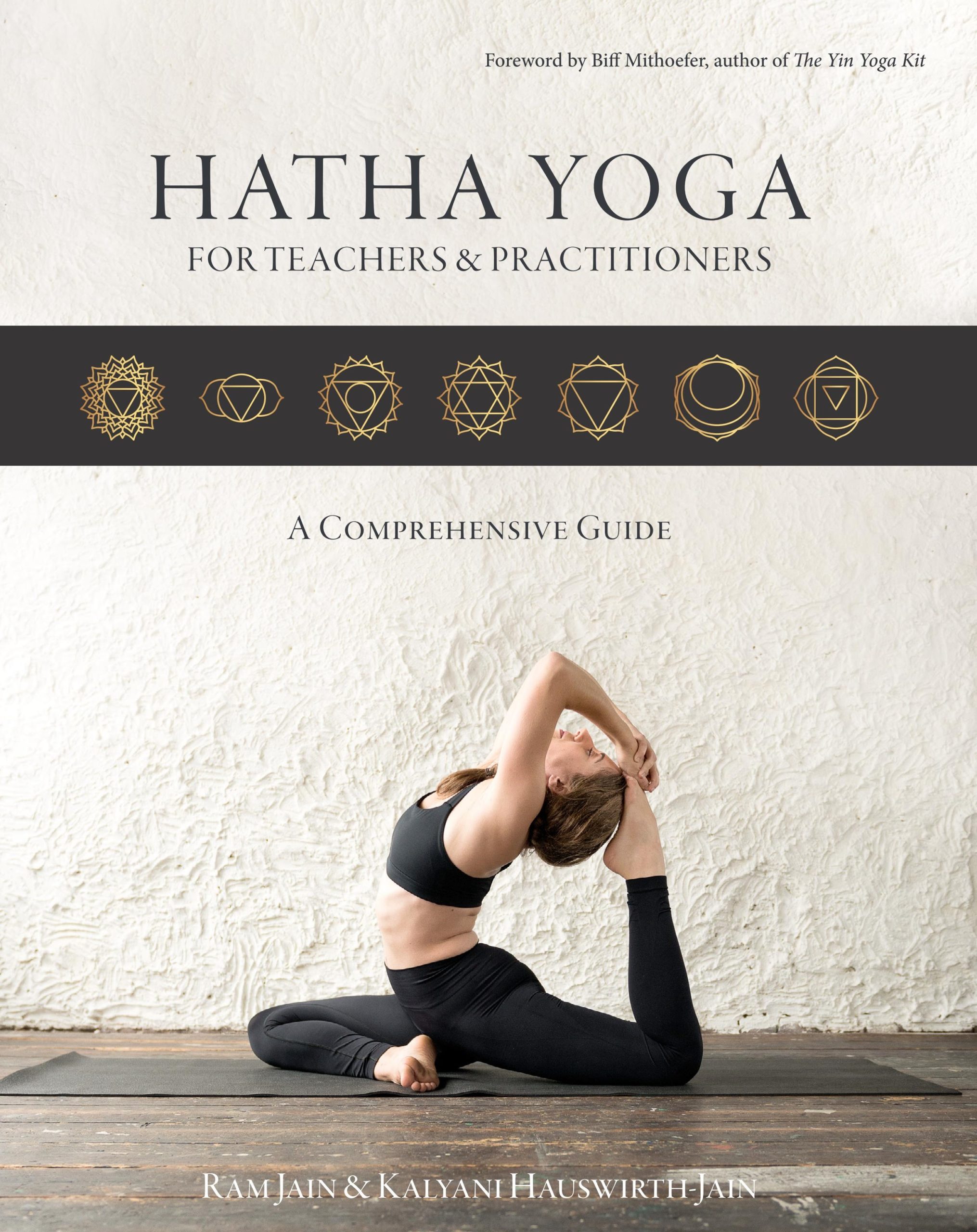
Get a free copy of our Amazon bestselling book directly into your inbox!
Learn how to practice, modify and sequence 250+ yoga postures according to ancient Hatha Yoga principles.
2. Plough Pose (Halasana)
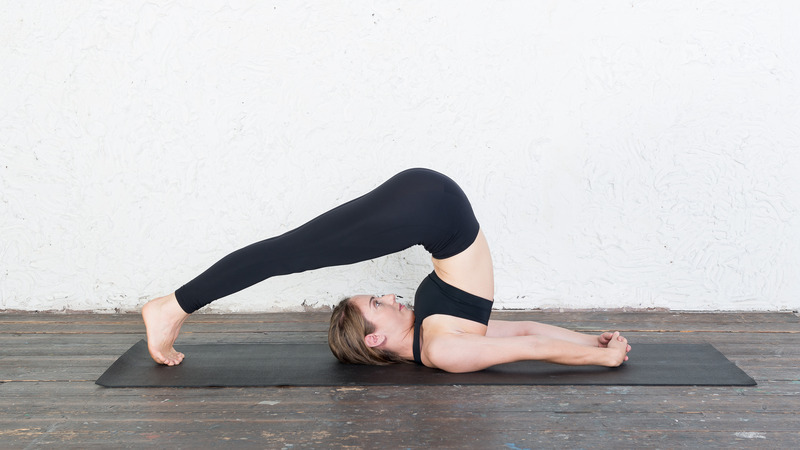
Look upwards toward the ceiling and do not turn your head sideways in Plough Pose (Halasana). If possible, keep your knees straight and hips above your shoulders. Remember to draw your shoulder blades towards each other to avoid pressure on your neck.
Modifications
- As in Shoulderstand, to relieve pressure on your neck, place a folded blanket under your shoulders.
- If you find it challenging to touch your feet to the floor, open your feet wider apart or support your feet with a block or against the wall.
Disclaimer: Do not practice Plough Pose (Halasana) if you are suffering from high blood pressure or other cardiavascular issues.
3. Upward-Facing Intense-Stretch Pose I (Urdhva Mukha Paschimottanasana I)
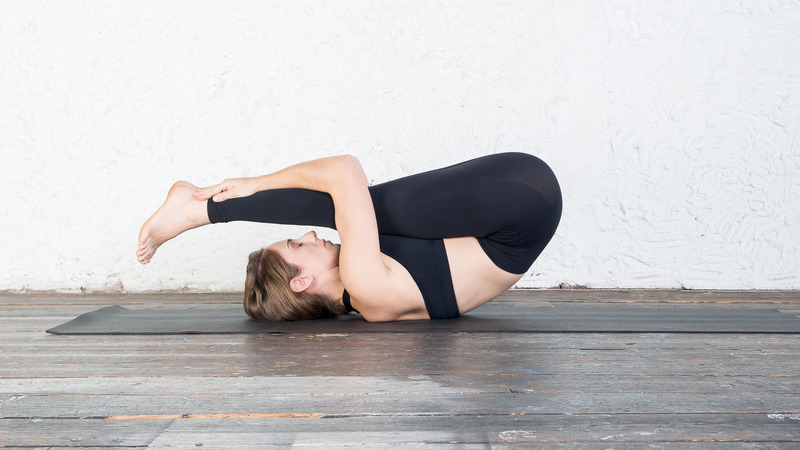
For correct alignment in Urdhva Mukha Paschimottanasana I, keep your head, shoulders and middle back on the floor while allowing your tailbone and lower back to lift. Your legs should be straight and your feet relaxed. Tuck your elbows towards your legs and draw your shoulders to your waist.
Modifications
- To relieve strain in your knees and hamstring, bend your knees slightly.
- If you experience tightness in your lower back or hips, open your legs hip-width apart.
4. Half Bridge Pose (Ardha Setu Bandhasana)
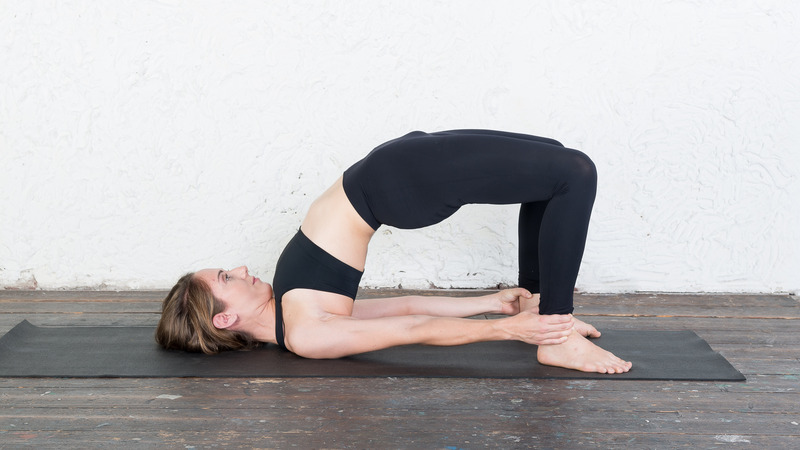
In Half Bridge Pose (Ardha Setu Bandhasana), your head and shoulders should be on the floor and shoulder blades drawn towards each other. Keep your knees parallel and at a 90-degree angle to the floor.
Modifications
- If you are finding it difficult to hold on to your ankles, keep your palms flat on the floor (next to your sides) or place your hands on your lower back (as in Shoulderstand).
5. Bridge Pose (Setu Bandhasana)
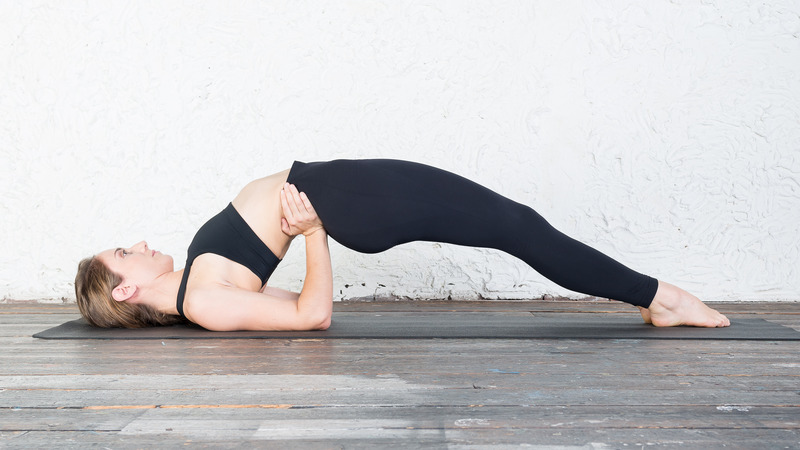
To move into Full Bridge Pose (Setu Bandhasana), start from Half Bridge Pose (Ardha Setu Bandhasana), place your hands on your lower back and walk your feet away from your body until your legs are straight and your feet are flat on the floor. For correct alignment, keep your shoulders on the floor and your elbows under your body, below your wrists.
Modification
- Keeping your legs straight might be challenging if you do not have a certain range of flexibility available in your lower back. To make the pose easier, walk your feet toward your body until you find a comfortable space. This means you will allow your legs to slightly bent.
6. Fish Pose (Matsyasana)
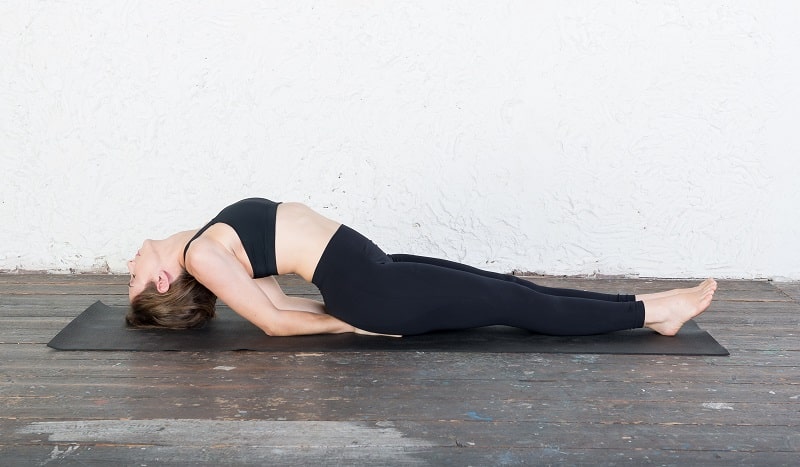
Fish Pose (Matsyasana) is an excellent chest and throat opener. Open your chest as much as possible and breathe deeply. Rest your head on the floor, but avoid placing weight on it. Instead, the weight should be only on your elbows. Keep your hands below your hips and feet and legs relaxed.
Modification
- Place a cushion under your head or upper back if you experience dizziness or neck pain.
7. Wheel Pose (Chakrasana)
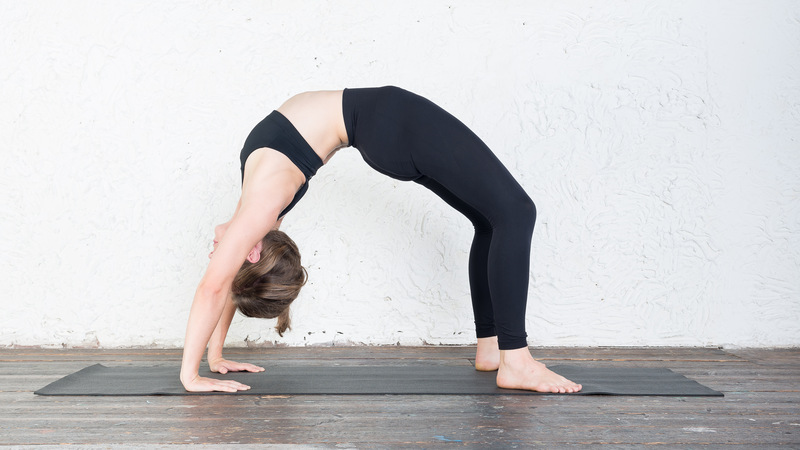
When practising Wheel Pose (Chakrasana), distribute your weight equally between your feet and hands. Relax your neck and focus on keeping your knees parallel and heels on the floor. Your arms should also be straight and parallel to each other, with elbows pointing backwards. Keeping your arms and knees parallel might be challenging, but still, be mindful of it.
Modifications
- For sensitive wrists, elevate them by placing a blanket under the heels of your hands.
- Turn your toes slightly outward if you experience tension in your knees.
- If you cannot push yourself up into Wheel Pose yet, place the crown of your head on the floor while lifting your pelvis and pushing upwards with your hands and feet.
8.Cat Pose I & II (Marjaryasana I & II)
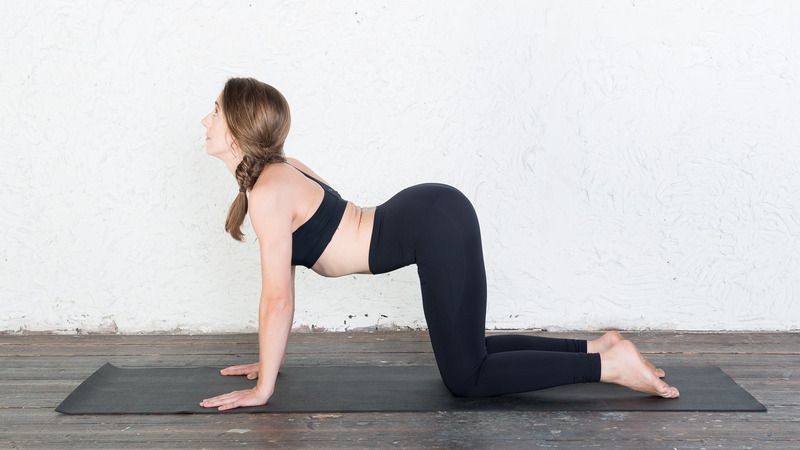
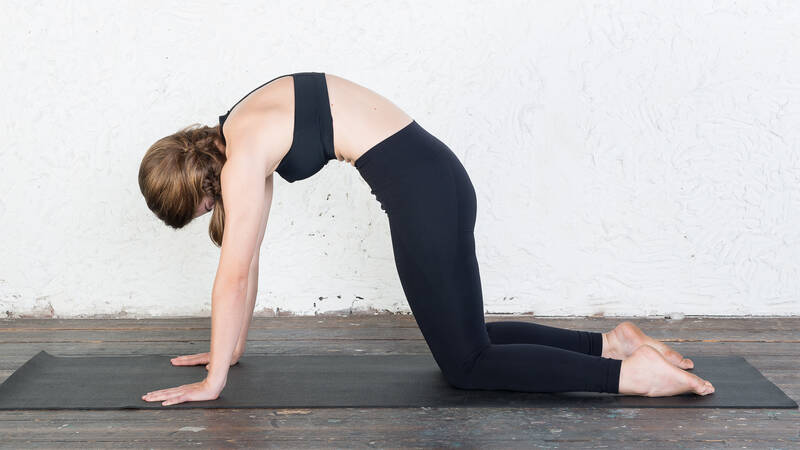
On all fours, place your knees below your hips and wrists below your shoulders. As you inhale, look up while arching your back and opening your chest (Marjaryasana I). As you exhale, bring your chin to your chest while rounding your back and pushing your hands and knees into the floor (Marjaryasana II).
9. Corpse Pose (Shavasana)
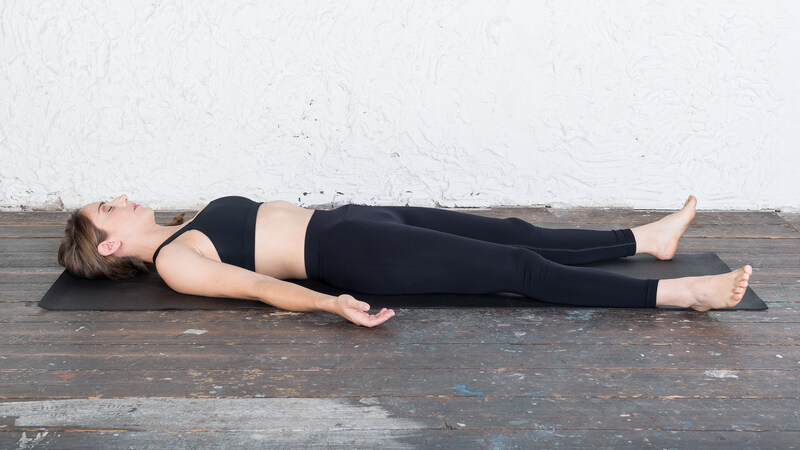
Corpse Pose (Shavasana) is the perfect pose to relax and breathe deeply. This deep relaxation activates your parasympathetic nervous system and reduces cortisol levels, resulting in improved thyroid function.
Need inspiration for more yoga poses? See our Yoga Asana Guide.
The Takeaway
Thyroid problems can take their toll on your physical and mental health. By practicing these yoga poses for thyroid issues, you will improve your overall health and alleviate some common symptoms. Although yoga can not treat the disorder, these specific asanas can provide relief. Yoga reduces thyroid symptoms in two ways; by increasing the blood circulation in the throat area or by relaxing the body.
Reference
Nilakanthan, Savitri, Kashinath Metri, Nagaratna Raghuram, and Nagendra Hongasandra. "Effect of 6 months intense Yoga practice on lipid profile, thyroxine medication and serum TSH level in women suffering from hypothyroidism: A pilot study." Journal of complementary and integrative medicine 13, no. 2 (2016): 189-193.
Research

Get a free copy of our Amazon bestselling book directly into your inbox!
Learn how to practice, modify and sequence 250+ yoga postures according to ancient Hatha Yoga principles.

